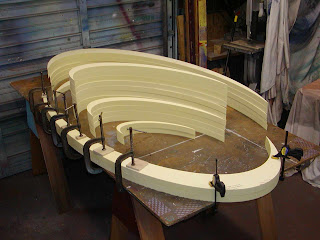I don't hand letter much anymore, so I don't work vertically much either. My adjustable 4' x 10' easel in the background has become clogged with a hodge podge of old signs and such. My own personal museum. In the middleground lies the proof that I'm secretly doing work for Nike.
Ah; the corner of my workbench where I process and mix paint. To the right is a ring stand that came out of the OSU Chemistry Dept. It's adjustable up & down and is perfect for holding a paint strainer. The whacked sculpture to the left is the result of years of stacking skins of paint which show up once a can of paint is half used. I'm doing my part to keep them out of the landfill. These skins are usually quite thin. The underside is wet enamel which provides the slow bonding. As I squish it into place, a trickle may run down the side. The skins are aligned to to outside edge. It started as 2 plywood cutouts in the shape of a guitar pick, held together with a 2" round steel pipe.
Background ovals of 1/2" MDO plywood with fresh black paint drying.
Part of designing the sign is also designing the bracket. I had all the steel bracket parts laser cut and supplied Larry Desaulniers a kit with plans, ready to weld. Larry is the general manager at Peak Sports and is a pretty dang good jack of many trades. This saved Peak on costs. I picked up the bracket and trucked it out to Tim Luke at Willamette Powder Fab to have it coated in black. The two halves of the sign are bolted together through the bracket. These bolts are hidden under the floating outer oval of the logo.
Designing the fab files for this project took some focus. The lighter of the two blue swooshes, both at the top of each sign face, are back to back. So the two faces are mirrored; the outer perimeter paths anyway. The logo reads left to right on both sides, so it is not mirrored. The black plywood panels outline the blue swooshes by a 1/2". Where the two swooshes come together the plywood has sharp indents. It is not a symmetrical oval. At this same place, the floating inside panel has points (outdents). It is not symmetrical either. All of the fastening holes were part of the cnc fab files. Keeping track of left and right, top and bottom, front and back, kept me on my toes. Also the bolting pattern through the steel frame was asymmetrical to dodge the logo. Every subtle design change meant extensive reworks & alignments of fastening holes. It was puzzling to keep track of top and bottom parts during production, and again front and back parts during assembly. Dizzy yet?
Who dressed the guy on the left!? On the right is Michael Butler from Sprick Roofing, assisting with the crane operations.
Up, up, and away.
Deja vu: fish out of water. Back when Keiko, the famous killer whale from the movie 'Free Willy', was moved to the Oregon Coast Aquarium in Newport, I did a rush job, lettering the large main boom on the crane that hoisted Keiko. The company was Continental Crane. They knew the images of their crane would be broadcast world wide in news stories. It was a massive crane and the letters were much larger than one would think. When finished, the client gave me a stuffed orca as a perk for meeting the tight deadline.
My close friend Nathan Potter could not miss out on the fun. In classic Nathan style, I was bumped off the podium, relinquished to direct from the sidelines.
The lower bolts went in this crawl space up in the attic. Dave, working from the outside, followed the holes in the bracket and drilled through the bricks on each side of the building corner. Larry was in this space communicating to me, up on the roof, with a 2-way radio. There were two large rectangular backing plates, of 1/4" steel plate, which he had to place the bolts through. These plates spread the load out over a larger area of multiple bricks. The plates and bolts were sized and specified from an engineer. Approval of the sign permit for this project required stamped engineering. This photo was taken for preliminary design work and consultation.
The upper bolts came through the parapet up on the roof. Each backing plate had an eye bolt with cable that joined together to anchor into this short section of exposed beam. This was not specified by the engineer, but presented itself as easy additional work. It adds a huge safety net, since the upper bolts endure the most force.























